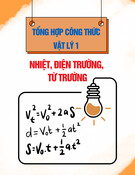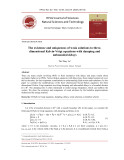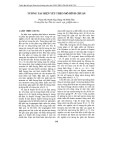
HPU2. Nat. Sci. Tech. Vol 03, issue 02 (2024), 70-79.
HPU2 Journal of Sciences:
Natural Sciences and Technology
Journal homepage: https://sj.hpu2.edu.vn
Article type: Research article
Received date: 30-4-2024 ; Revised date: 04-7-2024 ; Accepted date: 22-7-2024
This is licensed under the CC BY-NC 4.0
70
Viscosity solutions of the augmented
k
-Hessian equations
in exterior domains
Trong-Tien Phana, Hong-Quang Dinhb, Van-Bang Tranc*
aQuang Binh University, Quang Binh, Vietnam
bNinh So, Thuong Tin, Hanoi, Vietnam
cHanoi Pedagogical University 2, Vinh Phuc, Vietnam
Abstract
This paper examines the Dirichlet problem for augmented
k
-Hessian equations in exterior domains.
Building upon our previous results on the viscosity solutions to the Dirichlet problems for augmented
k
-Hessian equations in the bounded domain, and L. Dai, J. Bao's method to the
k
-Hessian equations
in exterior domains, a sufficient condition for the existence and uniqueness of viscosity solutions to the
Dirichlet problem for the augmented
k
-Hessian equations in exterior domains have been proven.
During the process, a slight adjustment to the result on the existence and uniqueness of viscosity
solutions to the problem in the bounded domains has been made for use in the present situation.
Keywords: Augmented k-Hessian equations, viscosity solutions, subsolution,
( , )Ak
-convex function,
exterior domain
1. Introduction
The viscosity solution of partial differential equations was first introduced for the first-order
Hamilton-Jacobi equations in the early 1980s. This generalized solution concept has been extended to
second-order nonlinear elliptic partial differential equations and has many applications, see [1]–[5] and
references therein.
* Corresponding author, E-mail: tranvanbang@hpu2.edu.vn
https://doi.org/10.56764/hpu2.jos.2024.3.2.70-79

HPU2. Nat. Sci. Tech. 2024, 3(2), 70-79
https://sj.hpu2.edu.vn 71
Let
n
D
be a domain,
{1,2, , }, n
kn
the set of all
nn
positive definite symmetric
matrices with the norm of the matrix
[]
ij
Xx
given by
max | |
ij
Xx
. For
,
n
X
we denote
1
( ) ( , , )
n
X
the vector of
n
eigenvalues of
X
,
1
1
11
1
( ) ( , , ) , ( , , )
k
k
n
k k n i i n
i i n
the basic symmetric polynomial of degree
k
. We consider the augmented
k
-Hessian equation
2 1/
[ ( ( ( ) ( , ( ), ( ))))] ( ), ,
k
kD v x A x v x Dv x f x x
D
(1)
subject to
( ) ( ), ,v x x x
D
(2)
where
:,
nn
A
D
:,f
D
and
:
D
are given continuous mappings,
0f
in
.D
When
0,A
Equation (1) is often called
k
-Hessian equation. It is well-known that the
k
-Hessian
equation is second-order nonlinear, and is elliptic only for
k
-convex functions (X. J. Wang [6]). The
k
-Hessian equation class includes the Monge-Ampere equations (when
kn
) and the Poisson
equations (when
1k
). It has many important applications, especially in conformal mapping problems,
and curvature theory [6]–[8].
The augmented
k
-Hessian equations appear when studying the optimal transport problems. When
the domain
D
is bounded, some properties of classical solutions to the Dirichlet problem (1), (2)
have been studied [9], [10], and some sufficient conditions for the existence and uniqueness of viscosity
solutions to that problem were proved in [11] when the data of the problem are not smooth enough. In
the case
\
n
D
is an exterior domain, where
n
is a bounded domain, and contains origin,
the existence of solution with prescribed asymptotic behavior to the problem (1), (2) has studied in [7]
and [8] (for
0,A k n
), in [12] and [13] (for
0, 1Af
), in [14] and [15] (for
0,A
f
is
unbounded and has a special growth).
In this paper, we establish a sufficient condition for the existence, uniqueness of viscosity solution
with prescribed asymptotic behavior to the problem (1), (2) on the exterior
\,
n
D
in the case
( , , ) 0A x z p
and
()fx
is bounded.
2. Research content
From now on, we always assume that
{1,2, , },kn
\
n
D
is an exterior domain, where
n
is a bounded domain, and contains origin
0,
:,
n n n
A
:n
f
are given
continuous mappings,
( ) 0,fx
and
: { : ( ) 0, 1,2, , }.
n
kj
jk
It is well-known that
{ : 0, 1,2, , }, , .
n
n j i j
j n i j

HPU2. Nat. Sci. Tech. 2024, 3(2), 70-79
https://sj.hpu2.edu.vn 72
For convenience, we will recall the concept of
( , )Ak
-convex function and the concept of viscosity
solution to Problem (1), (2).
Definition 2.1. ([11]). Given a pair
( , ).Ak
A function
()vCD
is said to be
( , )A k convex
on
D
iff for any
2( ),C
D
touches
v
from below at
0
xD
we have
2
0 0 0 0
( ( ) ( , ( ), ( ))) .
k
D x A x x D x
Remark 2.2. It is clear that if
2()vCD
and
v
is
( , )Ak
-convex on
D
then,
2
( ( ) ( , ( ), ( ))) , ,
k
D v x A x v x Dv x x
D
and for
2
C
-functions, the
(0, )n
-convexity is exactly the usual convexity.
Definition 2.3. ([15]). A function
()uCD
is called a viscosity subsolution to Equation (1) if for
any
,yD
any
( , )Ak
-convex function
2()C
D
satisfying
( ) ( ), ; ( ) ( ),u x x x u y y
D
we have
2 1/
[ ( ( ( ) ( , ( ), ( ))))] ( ),
k
kD y A y y D y f y
A function
()uCD
is called a viscosity supersolution to Equation (1) if for any
,yD
any
( , )Ak
-convex function
2()C
D
satisfying
( ) ( ), ; ( ) ( ),u x x x u y y
D
we have
2 1/
[ ( ( ( ) ( , ( ), ( ))))] ( ).
k
kD y A y y D y f y
A function
()uCD
is called a viscosity solution to Equation (1) if
u
is both a viscosity
subsolution and a viscosity supersolution to (1).
A function
()uCD
is called a viscosity subsolution (resp. viscosity supersolution, viscosity
solution) to the problem (1), (2) if
u
is a viscosity subsolution (resp. viscosity supersolution, viscosity
solution) to Equation (1) and
u
(resp.
,)
on
.D
Remark 2.4. By [11, Theorem 2.2], every viscosity subsolution and viscosity supersolution to the
equation (1) is
( , )Ak
-convex on
.D
Lemma 2.5. Let
n
D
be an arbitrary domain,
()
n
fC
be nonnegative. Suppose that
( , )Ak
-convex functions
12
( ), ( )
n
u C u C
D
are viscosity subsolutions to the equation (1)
respectively in
D
and
.
n
Moreover,
2 1 1 2
, ; , .u u x u u x DD
(3)
Set

HPU2. Nat. Sci. Tech. 2024, 3(2), 70-79
https://sj.hpu2.edu.vn 73
1
2
( ), ,
() ( ), .
n
u x x
vx u x x
D
D
Then
v
is a viscosity subsolution of the equation (1) in
.
n
Proof. Given
,
n
y
2()
n
C
be an
( , )Ak
-convex function satisfying
( ) ( ),v y y
( ) ( ), .
n
v x x x
(4)
If
,yD
then we get
11
( ) ( ) ( ), ( ) ( ) ( ),u y v y y u x v x x x
D.
Hence,
2
( ( ( ) ( , ( ), ( )))) 0, 1 ,
jD y A y y D y j k
2
( ( ( ) ( , ( ), ( )))) ( ).
kD y A y y D y f y
If
,yD
then we obtain
22
( ) ( ) ( ), ( ) ( ) ( ), .u y v y y u x v x x x
D
From (3), (4),
2( ) ( )u x x
for all
.
n
x
Therefore,
2
( ( ( ) ( , ( ), ( )))) 0, 1 ,
jD y A y y D y j k
2
( ( ( ) ( , ( ), ( )))) ( ).
kD y A y y D y f y
The proof is complete.
Now we introduce some assumptions for
( , , )A x z p
and
( ).fx
(
1
AF
): For each
0,t
there exists a locally continuous module
,At
on
[0, )
satisfies
,
( , , ) ( , , ) (| | (1 | |)) , , ,| | , ;
nn
At
A x z p A y z p x y p I x y z t p
(
2
AF
):
( , , ) 0; ( , , ) ;
nn
z
D A x z p x z p
(
3
AF
):
det( ( , , )) [ ( )] , ( , , ) ;
k n n
A x z p f x x z p
(
4
AF
): For each
0,t
there exists a positive constant
,ft
C
and a locally continuous module
,ft
such that
,
| ( ) ( ) | (| |), , ,| | , .
nn
ft
f x f y x y x y z t p
(
5
AF
): Let
be a
2,C
bounded, and strictly convex domain in
; ( ).
nC
The Dirichlet
problem
( ) Tr( ( , ( ), ( )), ,
( ) ( ),
v x A x v x Dv x x
v x x x
has a classical solution, where
TrA
stands for the trace of matrix
.A

HPU2. Nat. Sci. Tech. 2024, 3(2), 70-79
https://sj.hpu2.edu.vn 74
Remark 2.6. Some sufficient conditions for assumption (
5
AF
) have been established in some
documents, for instance: in [16] for
Tr ( , , ) ( ),A x v Dv f x
in [17] for
Tr ( , , ) ( ), 0,A x v Dv f v
in
[18] for
0,
and in [19], Theorem 15.10 for the general case.
According to the proof of Theorems 2.3, 2.4 in [11], but using the assumption (
5
AF
) instead of
using the sufficient conditions for (
5
AF
), we have the following result on the existence and uniqueness
to the Dirichlet problem for the augmented
k
-Hessian equation in bounded domains:
Theorem 2.7. Let
be a
2,C
bounded, and strictly convex domain in
; ( );
nC
( ), ( ) 0.f C f x
Moreover, suppose that the assumptions (
1
AF
)-(
5
AF
) are satisfied. Then the
following problem has a unique viscosity solution:
2 1/
[ ( ( ( ) ( , ( ), ( ))))] ( ), ,
( ) ( ), .
k
kD u x A x u x Du x f x x
u x x x
Now, we are ready to establish the existence and uniqueness for the considering problem in exterior
domains.
Theorem 2.8. Let
,( 3)
nn
be a bounded, strictly convex,
2
C
domain, which contains 0,
\
n
D
;
2( );C
( ),0 sup .inf nn
n
f C f f
Moreover, we assume that
( , , ) 0,A x z p
and satisfies the assumptions (
1
AF
)-(
5
AF
). Then there exists
0
such that for any
0,
there exists a unique viscosity solution to the problem in exterior domains (1), (2) such that
22
*
sup | | ( ) | | ,
2
lim n
x
x u x x
(5)
where
1/
*
1.sup n
k
k
n
f
C
Proof. We first construct a viscosity subsolution
t
v
to the problem (1), (2). For each
1,t
let
*
1/
||
( ) min ( ) , ,
nn
x
t
rn
v x r t dr x
where
*
2 diam .r
We have
( ),
n
t
vC
and
t
v
on
.D
Set
1/
2.
1
( ) min 1 1 2
n
n
rrd
t
t r r
r
Then
*
1/
2
*
||
( ) | | ( ) 1 1 , .
2
n
n
n
x
t
t
v x x t r dr x
r
(6)
By direct calculation, we have




















![Bộ câu hỏi lý thuyết Vật lý đại cương 2 [chuẩn nhất/mới nhất]](https://cdn.tailieu.vn/images/document/thumbnail/2025/20251003/kimphuong1001/135x160/74511759476041.jpg)
![Bài giảng Vật lý đại cương Chương 4 Học viện Kỹ thuật mật mã [Chuẩn SEO]](https://cdn.tailieu.vn/images/document/thumbnail/2025/20250925/kimphuong1001/135x160/46461758790667.jpg)




